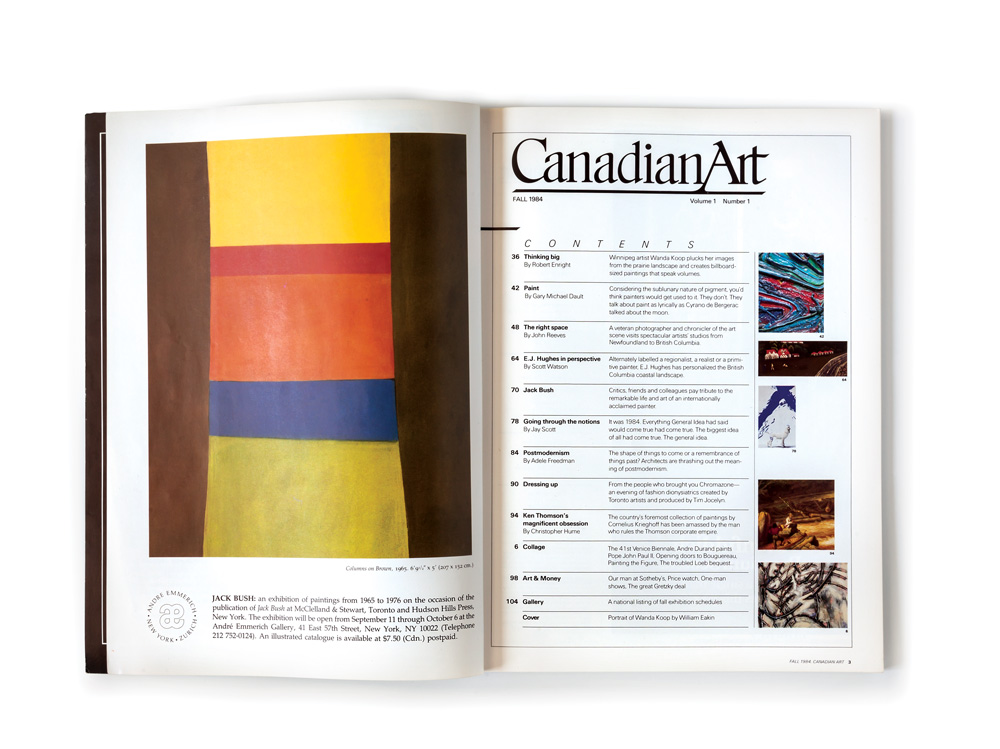The first issue of Canadian Art was 18 months in the making. The Fall 1984 premiere edition had engaged its editors—all but one of us outsiders in the very insider world of Canadian visual arts—in building contacts and introducing ourselves to artists, dealers, critics, collectors, curators, arts-agency officers and visual-arts supporters from coast to coast to coast beginning in early 1983. We had grand ambitions to be newsy, national, critical, colourful, multidisciplinary and, above all, readable. The idea was to provide a consumer-magazine approach to the visual arts.
Michael de Pencier, president of Key Publishers, had encouraged the start-up venture on the grounds that with the loss of artmagazine and artscanada, we, as successful publishers of Quill & Quire, should step into the breach. It was his notion to revive the Canadian Art (1943–66) title.
The first issue was a template for what was to come. Our priority was to build a team of contributors with credibility, and although Volume One, Number One wasn’t perfection, we got that part right.
Robert Enright delivered the cover story on Winnipeg artist Wanda Koop, who was our candidate for artist of the moment. Adele Freedman wrote a very cogent piece on postmodernist trends, then little understood by general readers.
Gary Michael Dault composed an eloquent essay on paint that was apposite for a period when Neo-Expressionist painting ruled. Jay Scott brought a fresh, insightful style to visual-arts writing with his feature on General Idea. And Vancouver curator Scott Watson revealed BC artist E.J. Hughes as a landscape artist, with a unique vision of the economic realities of his home province.
We reported on Tim Jocelyn’s Dressing Up at the Art Gallery at Harbourfront. We introduced (gasp!) the subject of Art and Money, writing up art-auction results. Contributing editor Lynn Cunningham worked with the writers to sharpen up their pieces and we set up an advisory panel of artists and curators to keep us on track.
The first issue, which went out to 5,000 subscribers—a feat managed by partner publisher Maclean Hunter’s circulation geniuses—was generally well-received.
But the art establishment—what we then called the A-list—was infuriated by Canadian Art. Artists and grants juries saw us as lightweight, because in the intensely hermetic style of art writing at the time, journalism was per se trivializing.
The quarterly gradually won over the art world, but as Sarah Milroy, then associate editor and later editor of the magazine, says, “We didn’t foresee all those platforms for arts reporting (CBC, general magazines, newspapers, etc.) shrinking the way they have,” such that Canadian Art is almost the last full-fledged national-culture mag left standing.
Neither did we forecast the way Canadian Art’s website would be a network for the visual arts and the innovative ways it would also bear witness to a vast variety of visual-arts activity.
Susan Walker was editor of Canadian Art from 1983 to 1988. This is an article from the Fall 2014 issue of Canadian Art. To read more from this issue, visit its table of contents.

 Contents page from the premiere issue of Canadian Art, Fall 1984. Photo: Christopher Dew.
Contents page from the premiere issue of Canadian Art, Fall 1984. Photo: Christopher Dew.







